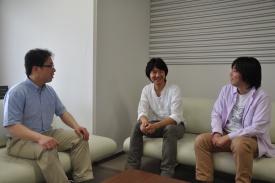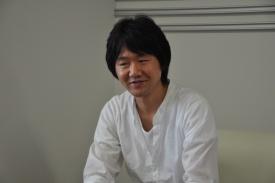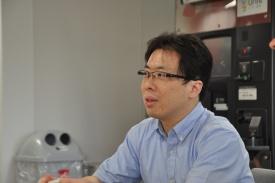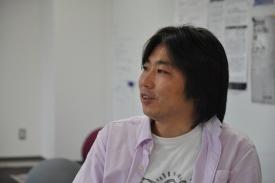

07/30/2012

Since its inception in 2007, the AIMR, as one of the inaugural research institutes of the World Premier International (WPI) Research Center Initiative, has pursued a program of innovative cross-disciplinary research that brings together techniques and know-how from a range of materials science-related fields. This approach — dubbed 'fusion research' — has attracted the attention of the material science community and already led to several important discoveries in the field. Now entering its sixth year of operation, the AIMR has embarked on a new research trajectory, with the introduction of an ambitious program of mathematics-driven materials research.
The new approach is thought to be the first of its kind in the world, and is based on harnessing the power of mathematics to answer fundamental questions in material science to open up new areas of investigation in the field and to guide AIMR scientists in the most promising research directions. Although this bold initiative has the potential to deliver important new advances, challenges remain in applying the approach to concrete research goals.
To gain insight into some of the challenges and future directions of research at the institute, AIMResearch talked to three young AIMR faculty members charged with the task of developing mathematics-driven materials science as part of their current research programs.

Natsuhiko Yoshinaga is an assistant professor in the AIMR Mathematics Unit and a specialist in the mathematics of soft condensed materials. He is optimistic about the prospect of merging materials science and mathematics, while also recognizing the potential challenges that lie ahead. “The new approach is very interesting because it brings together two quite radically different styles,” he says. “Traditionally, materials science research is largely empirical and involves a great deal of trial-and-error. By contrast, mathematics is all about setting clearly-defined parameters, then building and testing theories. Mathematics can help materials science research by providing mathematical tools to help make sense of experimental results.”
Bridging differences in the two distinctive research cultures is considered to be key to the success of the new strategy, and careful selection of research goals is crucial. To this end, initial efforts will focus on three research areas: non-equilibrium materials based on mathematical dynamical systems; topological functional materials; and multiscale hierarchical materials based on discrete geometric analysis that the AIMR has identified as being particularly suited to the mathematics-driven approach.
Some existing research themes at the AIMR are more likely to bear early fruit than others. Takeshi Fujita, associate professor of the Bulk Metallic Glasses (BMG) Group, shares his views on how mathematics can add value to his area of specialty: “Bulk Metallic Glasses are a good candidate for mathematics-driven research,” he explains. “Our work already involves a lot of calculation — for example, when investigating the effect of packing patterns on the properties of new materials. We expect that working with our colleagues in the Mathematics Unit will help to identify the most promising research leads and increase the speed at which we can realize new advances.”

Assistant professor Daisuke Hojo, a soft materials specialist in the Soft Materials Group at the AIMR, also sees great potential for the new approach. “We are currently researching the dispersive behavior of nanoparticles smaller than ten nanometers in non-polar solvents and building three-dimensional models of these systems,” he explains. “We want to use mathematics in our group to investigate how distribution of electric charges in the particles changes with structure. We are also examining the effect of different dispersion models on structure based on mathematical calculations.”
In addition to singling out specific problems in materials science for mathematics-driven treatment, the AIMR is spurring further integration of the two disciplines by encouraging “cultural exchange” between members of the mathematics group and other researchers at the institute through free discussion. As part of this initiative, researchers give informal talks on their research fields at a monthly event known as the “Friday Seminar” to colleagues from across the AIMR, as well as members of the Interface Unit, a group of theorists in physics and chemistry, set up as a bridge between mathematics and experimental materials scientists. Such activities offer an important way of connecting researchers with the wider mathematics community at Tohoku University and the Applied Mathematics Forum, an informal grouping of Tohoku University mathematicians.
Seminars focus on introducing fundamental principles in each field as well as presenting new research results, with the aim of helping colleagues from other groups at the AIMR to gain a deeper understanding of the general background to a research field. The sessions are purposely interactive, and joining in discussions and asking questions are positively encouraged.
In addition to discussion seminars and the weekly "Friday Tea Time" poster sessions for which the AIMR is well-known, researchers are encouraged to interact informally as much as possible. “Brainstorming is a very important way to help mutual understanding of the different ways in which materials scientists and mathematicians see the world,” says Hojo. “In our group, we meet with colleagues from the Mathematics Unit once a week to chat about what we’ve been doing, often without any formal focus. This kind of free discussion can lead to potentially interesting new ideas for experiments, or ways of improving our theoretical models.”

Yoshinaga adds, “Being able to interact with researchers from a different discipline on a daily basis is very stimulating. More often than not, we don’t have a fixed mathematical solution for problems in materials science, and so we need to work closely with our colleagues to develop a new approach or a different model. Some of the materials science research carried out here links in with really cutting-edge pure mathematics. Although we have only been working together for a short time, we have made a number of interesting advances in mathematics as well.”
The collaborative spirit that underlies fusion research at the AIMR has been a key theme from the very beginning, and now, with the addition of mathematics, this approach is being taken to the next level. Greater interaction between fields also opens up the possibility for researchers to publish papers in journals traditionally regarded as being out of their areas of specialty, leading to the exposure of their work to a more diverse audience.
“It is important to select research themes carefully,” says Fujita, “but if we get that right, then application of the mathematics-driven approach should accelerate progress and increase our scientific output, as well as opening up brand new research fields.”
By melding materials science with mathematics in this way, the AIMR continues its tradition of innovative fusion research directed at establishing new research frontiers, building on multidisciplinary exchanges, and ultimately developing breakthrough technologies for the benefit of the scientific community and human society.